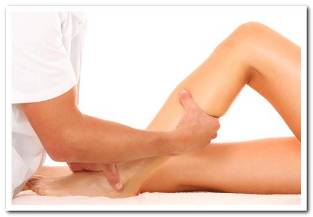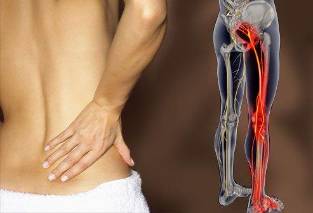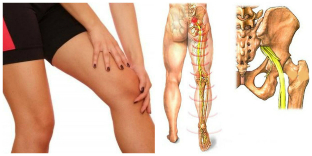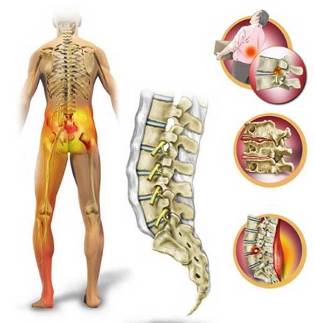This type of pain interferes not only live, but also to walk. How is it possible that pain, irritation, born in the back, able to penetrate in a limb and cause lameness? Even if the source is much higher, we feel its influence in so great a distance: back pain, but numb, and pull the legs. In that way, the pain in the back gives way?

The causes of damage are pain in the legs can be air-currents, back pain, hernia, tumors, and stress
This occurs through a neural reflex nature of the pain, its ability to extend for the entire length of the nerve coming from the spinal cord. If this nerve where it irritates, occurs remote response.
One of the possible causes of leg pain can be an inflammation of the sciatic nerve
In lumbosacral department is the plexus of nerve fibers that emerge from the vertebrae l4, L5 and S1 — S3. This plexus called the sciatic nerve. Leave the muscle, pear-shaped, he literally splits into two for the thighs then it should and ankle muscles and the joints, being the most powerful and longest nerve of the human body.
The inflammation of the sciatic nerve thus responds to the lower limbs. The pain, which appeared in the lower part of the back and the date in the legs, called lumbosciatica. Usually suffers (badly or pulls) on the leg, on the side of the nerve, but it happens and two-way reaction in which both my legs hurt.
The pain is not limited, and the patient to pursue other unpleasant feelings:
- Walk to nothing, lose their sensitivity, draw or numb
If they hit the nerve at the level of the sacred, with the activation of the gluteal muscles and thighs, syndrome of the tail bone and the foot is called sciatica.
Very often people share the pain in the back and the leg in two different categories and they do not see the root cause. "I hurt the right knee, numb foot. I can't come to walk and climb the stairs", — detail, describing the state of their arts, and forgetting about the pain in the back, that all of this was preceded. Ask also to the "incompetence" of doctors, instead of treating osteoarthritis of the knee, you suddenly start to do the spine.
But it is the spinal column with its stimulating the nervous, muscular-ligament, and the vascular system is the main cause of the sciatica.
Because the pain, pull and paralyze the legs
- The ordinary current of air can be the cause of low back pain low back pain, gave up. The same consequences can bring the seat on a surface that is cold, swimming in cold water, and similar causes. All of them can be grouped under the term "hypothermia"
- Low back pain — dystrophic a degenerative process in the lumbosacral department periodically causes severe pain, tends to a limb. The reason for the deformation of the disc damage nerve fibers and cause inflammation
- Education, protrusion and herniated disc can cause the pain syndrome with very high intensity, if this occurs, the compression of the nerve. A pulse of pain covers an area of innervation with the speed of the current. It is interesting to note that the feeling on the affected part, also, like symptoms, defeat the weak current: Tingling, burning sensation, creeping chills, sensation of cold. These symptoms are called paresthesia. If the legs do not hurt, but only numb, this may mean that, because of prolonged compression of the nerve fibres, have begun atrophic processes
- Other diseases (spondylitis, spondiloartrosi spondylolisthesis), lead to restricting the mobility, and stagnant phenomena in bone tissues, muscles, nerves, and blood vessels, which stimulates the inflammatory processes
- Tumors of the spine, and tuberculosis can also cause inflammation of the sciatic nerve and the feeling that pulls and tingling in the extremities
- Stress is not a harmless phenomenon, and it never goes unnoticed, especially where there are involved the nerves
Classification of pain of the back and legs

In the source, all types of back pain, sacrificed in a limb, can be conventionally identified in three main groups:
- The first group linked to neuroreflex the nature of pain, and pathological processes in the spine.
Here you can enter all DDP (degenerative-dystrophic processes), for the reason that were being violated all of the metabolic processes in the tissues and their power, but also of infectious diseases, inflammatory diseases, and developmental dysplasia of the spinal column. A threat to the nerve fibres here double:
- They are direct mechanical stress from the side of the mesh of the spinal column
- Dystrophic changes begin to happen in us nerve fibers
- The second group is associated with muscular dysfunction in the back or in the legs. Causes several. This:
- Scoliosis of the vertebral column, with which they form persistent asymmetry of muscle groups, located on both sides of the arch
- The increase in the load on certain muscles as a result uncomfortable physical posture or an over-voltage
- Muscle myositis, caused by hypothermia, infectious processes, or congenital defects
- The leg pain often occurs for reasons quite trivial — walking in high heels Cause pain in the legs can become uncomfortable high-heeled shoes
- Autonomic dysfunction — the third of the origin of the sciatica
Self-visceral violation — is a symptom, which includes all the irregularities of the functioning of the internal organs and systems of the body, associated with impaired adjustment of the autonomic nervous system (ANS)
The autonomic nervous system is closely linked with the central according to the principle of right and of feedback:
- Errors in the central nervous system, local damage to the spinal nerves and fibres they generate interruptions in the CNS
- Vegetative violations include response nerve of the central nervous system, in the area of innervation which are
Especially often problems with the legs can occur when stand-alone-vascular in the area of lumbo-sacral spine. Poor blood flow can cause pain in the back and limbs, muscular dystrophy of the legs.
Summarizing the above, we can conclude:
Learn, why they hurt, pull and paralyze the legs because of the pain, born in the back, is possible only after a careful diagnosis:
- The history of data
- X-ray, computed and magnetic resonance research of the spine
- Angiography of the blood vessels
- Laboratory studies, etc.
Treatment of pain in the back and legs
The treatment should be completely adequate because of illness.

- If the pain is generated from the DDP, is this:
- Painkillers and anti-inflammatory drugs (NSAIDS)
- Traction techniques traction of the spinal column by means of suction)
- The chiropractic and acupuncture
- The application of low frequency current, magnetic therapy and other physiotherapy techniques hardware
- Pilates exercises
- When muscle dysfunction caused by scoliosis, also used:
- Special corrective exercises
- Wear corsets
- Treatment of myositis is executed with success:
- Irritating ointments (if myositis is not caused by an infection)
- Massage, physiotherapy
- In some cases, you may need an anti-microbial treatment
- When vascular dystonia prescribed a full treatment:
- Vasodilators
- Angioprotectors
- Vitamins and stimulating the metabolic processes
- Sedative
Treatment reflect pain is always a long process, as well as usually occur when the chronic diseases of long standing, reflected on the nervous system of the man
So, if you are back hurt, try to identify immediately the cause of the pain and start the treatment without waiting for the time when they begin to hurt, numb, or pull the feet.
If the back pain gives way, first think of low back pain (sciatica) or radicolite. Especially if you numb the fingers, and the pain in his leg. Often. And few remember that these symptoms can be and at other diseases, for example, when acute appendicitis.

Causes
- The most frequent cause is disease of the spinal column (back pain, scoliosis, sciatica, cervical, sciatica, slipped disc, spondylitis, spondylolisthesis, and other degenerative diseases of nature, but also of complications post-traumatic, tumors, and infectious process);
- Pathology of the organs of the lower divisions of the abdomen (kidney stones, cystitis, salpingoophoritis, adhesive process, inguinal hernia, appendicitis, and other).
Important: On rare diseases, leading to the emergence of this ' we ' syndrome, it should not be forgotten.
A disease of the bones and muscle structures
The syndrome of low-back pain associated with disease of the spine and the dominant lower limb, called lumbosciatica.
When the degenerative process at the lumbar part of the spine, the pain often develops due to compression of the nerve roots and giving a lower limb to the main nerve of the brachial plexus — sciatic, is divided into fibular and tibial. Latest gives in the popliteal fossa the beginning of nerves in the calf.
Compression of the nerve roots occurs during the destruction of the cartilage in the background degenerative dystrophic reactions. This decreases the distance between the vertebrae, and, as a result, they have become more small holes for the spinal roots. When herniated discs are irritated directly protrusion hernia, when the tumour — pathological tissue neoplasms, when spondylosis — bony growths, called osteophytes.
Against the background of a pathological process always develops an inflammatory reaction such as swelling and disorders of the function of the surrounding tissues, which worsens the circulation of the affected area, deleted the normal metabolic processes. The consequence of this is the increase in muscle tone in the area of innervation disadvantaged roots, which leads to an increase of the pain.
The development of changes in the spine, usually indicated with the end of the processes of ossification for about 25 years and is considered to be a physiological phenomenon normal. What is premature aging of the system, the muscle and the cartilage of the structures it is possible to pause, if only to respect the principles of proper nutrition and strengthen the muscles of the back special exercises.
Other than the pain
The disease of the spine, you experience the following types of sciatica:
- Muscle-toned — shows a strong a strong spasm, when you develop the movement compensatory curvature of the spine, the movement of the back are limited;
- Autonomic-vascular — syndrome of pain, burning character, accompanied by a sense of numbness in the forefoot area may appear a sensation of cold or warmth in a limb especially when you try to change the position of the body. So it reacts the vascular system on the pathological process;
- Neurodystrophic — develops pungent spasm mostly at night, sometimes the skin above the pathological outbreak tapers off.
Important: Often, the pain is mixed. Some other form of sciatica, in its most pure form is rare.
The clinical manifestations of some diseases of the spine
- Osteochondrosis of the pain can be acute or chronic. The acute pain occurs after the strong movement or lifting weights. Often when you are numb and both legs, pain in area of hip joints and of the movement of the back drastically limited.
Chronic pain is almost a constant companion of life, to which we are accustomed, as well as a slight gap is very small. With this pull in the lumbar region and the movement of the branches of the sciatic nerve.
- When herniated disc, localized in the lumbar area, pain may not be much, but it broke the function of the pelvic organs: this pulls "piss in bathroom", can develop urinary incontinence, in feet, observes a tingling sensation and "thrills chills".
With the development of pain syndrome may develop paralysis of the lower limbs, due to full compression motor roots. But, more often, of those serious consequences of a pathological process still does not arrive.
- For sciatica, back pain lumbar gives the step, when this appears, lameness, muscle pains and pulls. Can decrease the sensitivity of the postero-lateral surface of the tibia and the dorsum of the foot. Relief in the supine position, the back should be relaxed. Sometimes the pain is attenuated in the "fetal position".
Pathology of the internal organs
Often the back pain, down the leg, are the manifestation of a pathology of internal organs. Limb in this numb, to the movement of the nerve pulling, and the pain can also give in the groin.
- Kidney disease can manifest itself described the symptom, when the stone is in the ureter;
- Disease adhesive nerves can push the toes;
- Salpingoophoritis, uterine fibroids, endometriosis also manifest discomfort in the lumbosacral segment and the leg on the side of the lesion;
- Acute appendicitis when the atypical position of the appendix processus (retroperitoneal surface of the rear blind colon) occurs pull the pain in the lumbar region the right, which gives the right leg. If in supine position, try to lift the right leg involuntarily bends and expands outward.
Similar phenomena are explained the characteristics of the innervation of the organs of small pelvis and legs.






































